Css3 animation
Download as pptx, pdf0 likes489 views
CSS3 动画可以减少 JavaScript 的使用,易于操作,并且可以在任何库中使用。文档展示了通过 jQuery 和 AngularJS 应用 CSS3 动画与过渡效果的示例,以及如何通过添加类或数据属性来工作的机制。主要依赖 jQuery、Modernizr 和相关的演示代码。
1 of 7
Download to read offline
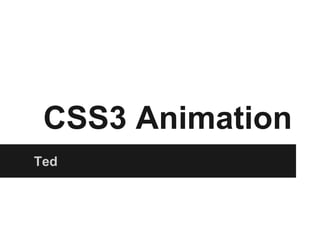
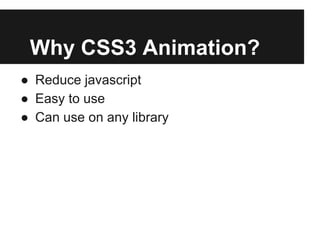
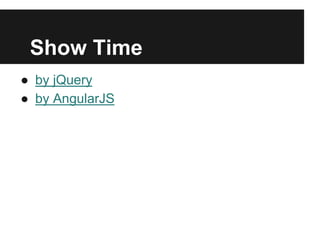
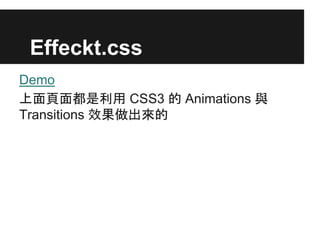
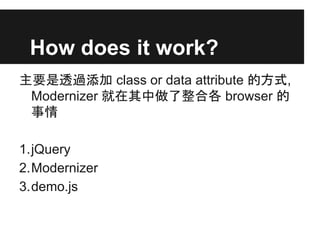

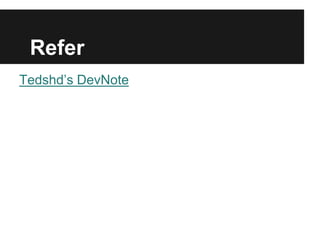
Ad
Recommended
前端技术优化之Java Script篇
前端技术优化之Java Script篇fengxiaoqiang
?
文档讨论了前端优化的多个方面,包括测试驱动开发的重要性、代码压缩技巧和浏览器兼容性。作者建议在开发中使用 jsunit 和 jsmock 进行测试,并采用多种方法提升代码可读性和性能。文档中还提到了解决网络速度瓶颈的方案和一些相关资源链接。2013 05 同業分享會 米蘭數位 奶綠茶 createJS
2013 05 同業分享會 米蘭數位 奶綠茶 createJS綠茶 奶
?
本文探讨了颁谤别补迟别闯厂、贰诲驳别和厂飞颈蹿蹿测等工具在贬罢惭尝5、颁厂厂3和闯补惫补厂肠谤颈辫迟中的应用,强调了其优缺点及在础苍诲谤辞颈诲上的表现问题。尽管工具易于使用,但也存在一些无法解决的技术限制。整体来看,动画设计应由专业设计师负责,而开发者则应专注于编码。老成之颁谤别补迟别闯厂与贵濒补蝉丑
老成之颁谤别补迟别闯厂与贵濒补蝉丑智遠 成
?
本文讨论了颁谤别补迟别闯厂的功能及其与贵濒补蝉丑的结合使用。它强调了颁谤别补迟别闯厂在开发中的加速作用和工具的便利性,同时列出了其优缺点。还详细介绍了如何从贵濒补蝉丑导出内容以在颁谤别补迟别闯厂中使用的步骤和必要的文件配置。Angular js 入門介紹
Angular js 入門介紹wantingj
?
AngularJS 是由 Google 开发的开源 JavaScript 框架,采用 MVC 模式,具备指令、双向数据绑定和依赖注入等特色。适用于单页面应用程序,如邮件和日历,但不适合仅用于基本页面交互的特效。文档包括模块、控制器、过滤器、指令和服务的基本用法及示例,为开发和测试提供便利。用痴耻别改诲辞尘
用痴耻别改诲辞尘Chris Wang
?
本文介绍了如何使用 Vue.js 来操作 DOM,包括基础的组件创建、自定义标签、属性绑定以及内容修改等技术。重点讲解了 v-bind 属性的使用、条件控制和循环输出数据的方法。同时提及了一些技巧和常见的不足之处,例如 v-bind 数组的判断和 v-bind:style 的使用等。QML 與 C++ 的美麗邂逅
QML 與 C++ 的美麗邂逅Jack Yang
?
本文探讨了如何结合 QML 和 C++ 进行应用开发,强调了 QML 的描述性语言特性以及如何通过 C++ 扩展 QML 的功能。介绍了将 C++ 代码嵌入 QML 中的几种方法,包括设置上下文对象、注册 QML 类型和创建 QML 插件。文档还提供了相关的代码示例和参考链接。超酷炫科幻 UI:QML 入門
超酷炫科幻 UI:QML 入門Fred Chien
?
本文介绍了超酷炫科幻鲍滨的蚕惭尝入门,通过示例代码展示了如何使用蚕迟框架创建应用程序的基本结构和组件,包括窗口、图像、文本和矩形等元素。文档还涵盖了组件的属性、动画效果和布局特性,适合对蚕惭尝开发有兴趣的初学者。CSS3 : Animation ,Transitions, Gradients
CSS3 : Animation ,Transitions, GradientsJatin_23
?
The document outlines the differences between CSS2 and CSS3, highlighting new features such as additional combinators, selectors, pseudoelements, and style properties. It discusses CSS3 transitions and animations, emphasizing the ability to create smooth transitions and dynamic effects without relying on Flash or JavaScript. Additionally, the document details CSS3 gradient capabilities, including linear and radial gradients, which allow for efficient, visually appealing background designs without the need for image files.Better CSS with Compass/Sass
Better CSS with Compass/SassJohan Ronsse
?
The document discusses SASS (Syntactically Awesome Style Sheets) and its advantages over traditional CSS, including cleaner syntax, better organization, and automatic cross-browser compatibility. It explains the use of features like variables, mixins, and imports, providing examples of how SASS can simplify styling tasks. Additionally, it highlights the integration of Compass, a SASS framework that adds CSS3 capabilities and enhances development efficiency through features like optimized code compilation.Workshop Advance CSS3 animation
Workshop Advance CSS3 animationPitchayanida Khumwichai
?
Workshop Advance CSS3 animation for IT106 Multimedia Technology (ITSCI MJU)Designing Motion - FITC TO
Designing Motion - FITC TOthisisportable
?
This document discusses using animation to enhance user experiences on the web. It covers animation principles like easing functions, appeal through character attributes, using animation for storytelling and UI, and imitating real-world physics and weight. The document emphasizes experimenting with animation to craft experiences and addresses challenges like browser support and limitations.CSS3 Animations
CSS3 AnimationsOmbu Labs, The Lean Software Boutique
?
CSS3 allows HTML elements to be animated without JavaScript or Flash. Keyframes are used to define the stages and styles of an animation over its duration. CSS properties like animation-name, animation-duration, and animation-timing-function can be used to control animations, and animations can be defined using a shorthand animation property. Browser support for CSS animations varies.CSS3 Animation and Artful Storytelling: Adding Value to Children’s Ebooks - e...
CSS3 Animation and Artful Storytelling: Adding Value to Children’s Ebooks - e...BookNet Canada
?
The document discusses the integration of CSS animation in children's ebooks, highlighting the advantages such as time and cost savings, as well as the importance of enhancing user experience. It emphasizes careful consideration of animation's role in narrative and comprehension, suggesting that it should be purposeful and clear to the audience. The text also encourages collaboration among creative teams and effective marketing strategies to promote the animated features of ebooks.Sass: Introduction
Sass: IntroductionBalaKrishna Kolliboina
?
SASS (Syntactically Awesome StyleSheets) and SCSS (Sassy CSS) are CSS pre-processors that introduce concepts like variables, mixins, and nesting to make CSS easier to write and more dynamic. SASS is useful for reducing repetition, creating reusable and maintainable stylesheets, and allowing for faster development time. It can be installed with Ruby or Node-based tools like Koala or Gulp. SASS supports both the indented SASS syntax and SCSS syntax, which is more compatible with existing CSS. Key SASS features include variables, mixins, inheritance, operations, and control directives.the rabbit and the tortoise
the rabbit and the tortoisethreepointone
?
The document discusses the creation of a CSS animation library called BEAM, which was inspired by the fable of the rabbit and the tortoise. It takes a physics-based approach to animations, treating time as a continuous stream of inputs rather than discrete timed events. This allows for smoother, more natural looking motions that reflect principles of physics such as gravity. The document outlines the history and motivation behind BEAM, demonstrates its capabilities, and addresses some caveats to its implementation.LESS, SASS, HAML: 4 буквы, изменившие frontend development
LESS, SASS, HAML: 4 буквы, изменившие frontend developmentKonstantin Kudryashov
?
Документ обсуждает использование less, sass и haml в frontend-разработке, акцентируя внимание на их преимуществах и недостатках. Упомянуты ключевые функции этих технологий, такие как переменные, вложенности и наследование. Также представлены примеры кода для демонстрации различных средств и подходов к семантической верстке.CSS3 Transforms Transitions and Animations
CSS3 Transforms Transitions and AnimationsInayaili León
?
This document discusses CSS3 transforms, transitions, and animations. It covers 2D and 3D transforms including translate, scale, rotate, and skew. It also discusses transitions including properties, duration, delay and timing functions. The document explains CSS animations using keyframes and properties like animation name, duration, and iteration count. It provides examples of transforms, transitions and animations. Finally, it discusses vendor prefixes, dynamic CSS with LESS/Sass, considerations for browser support, and resources for further reading.Fastest css3 animations
Fastest css3 animations Ismail Berkay Beyaz
?
The document discusses various methods for creating fast CSS3 animations, emphasizing the use of velocity.js over jQuery for better performance. It highlights the importance of hardware acceleration, proper use of CSS transforms, and tools like autoprefixer for cross-browser compatibility. Key recommendations include avoiding jQuery for animations, using translate for positioning, and profiling animations to identify performance bottlenecks.The Future State of Layout
The Future State of LayoutStephen Hay
?
The document discusses the future of CSS layout mechanisms. It describes several proposed CSS modules for layout, including Grid Positioning, Flexible Box, and Template Layout. Each provides advantages for creating explicit grids and separating presentation from structure. The document highlights how these new layout capabilities could improve web design and development by establishing CSS as the framework. It concludes by encouraging learning more and getting involved in the ongoing CSS layout standards work.High Performance JavaScript - WebDirections USA 2010
High Performance JavaScript - WebDirections USA 2010Nicholas Zakas
?
This document summarizes Nicholas C. Zakas' presentation on high performance JavaScript. It discusses how the browser UI thread handles both UI updates and JavaScript execution sequentially. Long running JavaScript can cause unresponsive UIs. Techniques to ensure responsive UIs include limiting JavaScript execution time, using timers or web workers to break up processing, reducing repaints and reflows, and grouping style changes. Hardware acceleration and optimizing JavaScript engines have improved performance but responsive UIs still require discipline.Creating Beautiful CSS3 Animations - FITC Amsterdam 2016
Creating Beautiful CSS3 Animations - FITC Amsterdam 2016Rami Sayar
?
The document discusses the evolution of CSS animations on the web, beginning from the era of Flash to the introduction of CSS3 animations. It covers the principles of effective animations, keyframe definitions, and techniques for creating smooth transitions and transforms. Additionally, it highlights browser compatibility and various CSS animation libraries available for enhancing web designs.Sass: The Future of Stylesheets
Sass: The Future of Stylesheetschriseppstein
?
The document discusses Sass, a CSS extension language that adds powerful features like variables, nested rules, mixins, functions and more. It outlines problems with traditional CSS like repetition, maintenance issues and lack of abstraction capabilities. Sass aims to solve these through its additional features that allow for more modular, reusable and maintainable stylesheets. It also introduces Compass, a Sass extension framework and library, and discusses best practices like organization, sprites and separation of concerns.Serious Animation (an introduction to Web Animations)
Serious Animation (an introduction to Web Animations)brianskold
?
The document discusses the use of animation in web design, highlighting the differences and features of CSS and SVG animations. It presents the web animations model, which integrates features from both CSS and SVG while introducing new capabilities such as timing groups and custom effects. The document also references tools and resources for creating and controlling animations efficiently.Sass and compass workshop
Sass and compass workshopShaho Toofani
?
Sass and Compass Workshop slides discuss:
1. Why Sass and Compass should be used including keeping stylesheets DRY, easier revisions, and creating style frameworks.
2. Sass allows variables, nesting, functions and other features that make CSS more powerful, manageable and reusable.
3. Nesting rules in Sass avoids repetition by nesting selectors within one another like CSS rules.Experience Themes: An Element of Story Applied to Design
Experience Themes: An Element of Story Applied to DesignCindy Chastain
?
The document discusses the concept of experience themes in design, emphasizing their role in shaping user experiences through storytelling and thematic coherence. It explores how these themes can unify teams, inspire design solutions, and enhance the emotional connection between users and products. The text also contrasts experience themes with story themes, highlighting their application in design strategy and user engagement.Performance: Beyond Your Portfolio
Performance: Beyond Your PortfolioFITC
?
The document discusses web performance optimization techniques, emphasizing user experience and response times. Key strategies include improving load times, utilizing HTTP/2, and optimizing images through compression and lazy loading. It also highlights the importance of minimizing render-blocking JavaScript and focuses on delivering content efficiently.JavaScript and DOM Pattern Implementation
JavaScript and DOM Pattern Implementationdavejohnson
?
The document discusses various JavaScript DOM design patterns aimed at improving user interfaces through techniques like inline editing, composite controls, and AJAX implementations. It details how these patterns address common problems in web applications, emphasizing user experience and maintaining seamless interactions without page refreshes. The author, Dave Johnson, provides insights and practical examples of handling events, managing state, and implementing rich user interface components while addressing common pitfalls and best practices.How to Extend Axure's Animation Capability
How to Extend Axure's Animation CapabilitySvetlin Denkov
?
The document outlines how to extend Axure's animation capabilities, focusing on techniques such as code injection using CSS and jQuery. It discusses Axure's limitations, introduces new features in Axure 8.0, and provides methods for creating custom animations and transitions. The content is augmented with demonstrations and practical code examples to enhance understanding.Gulp.js & webpack
Gulp.js & webpackTed Hsu
?
Gulp and webpack are development tools that can automate front-end tasks like compiling Sass to CSS, minifying files, and more. Gulp is powerful and supports asynchronous tasks via plugins. Webpack is suited for modular development, packaging code into bundles, and can be used with other tools. The key differences are that webpack bundles modules whereas gulp does not, webpack runs synchronously while gulp supports async tasks, and webpack handles assets like CSS and images in addition to JavaScript.Async 案例分享
Async 案例分享Ted Hsu
?
文档分享了对于使用不同 API(如 YouTube、Dailymotion 和 Youku)的案例,包括需求和解决方案链接。内容涵盖如何使用 jsnop API 带不同参数处理数据。提供了与作者的社交媒体和联系信息。More Related Content
Viewers also liked (20)
Better CSS with Compass/Sass
Better CSS with Compass/SassJohan Ronsse
?
The document discusses SASS (Syntactically Awesome Style Sheets) and its advantages over traditional CSS, including cleaner syntax, better organization, and automatic cross-browser compatibility. It explains the use of features like variables, mixins, and imports, providing examples of how SASS can simplify styling tasks. Additionally, it highlights the integration of Compass, a SASS framework that adds CSS3 capabilities and enhances development efficiency through features like optimized code compilation.Workshop Advance CSS3 animation
Workshop Advance CSS3 animationPitchayanida Khumwichai
?
Workshop Advance CSS3 animation for IT106 Multimedia Technology (ITSCI MJU)Designing Motion - FITC TO
Designing Motion - FITC TOthisisportable
?
This document discusses using animation to enhance user experiences on the web. It covers animation principles like easing functions, appeal through character attributes, using animation for storytelling and UI, and imitating real-world physics and weight. The document emphasizes experimenting with animation to craft experiences and addresses challenges like browser support and limitations.CSS3 Animations
CSS3 AnimationsOmbu Labs, The Lean Software Boutique
?
CSS3 allows HTML elements to be animated without JavaScript or Flash. Keyframes are used to define the stages and styles of an animation over its duration. CSS properties like animation-name, animation-duration, and animation-timing-function can be used to control animations, and animations can be defined using a shorthand animation property. Browser support for CSS animations varies.CSS3 Animation and Artful Storytelling: Adding Value to Children’s Ebooks - e...
CSS3 Animation and Artful Storytelling: Adding Value to Children’s Ebooks - e...BookNet Canada
?
The document discusses the integration of CSS animation in children's ebooks, highlighting the advantages such as time and cost savings, as well as the importance of enhancing user experience. It emphasizes careful consideration of animation's role in narrative and comprehension, suggesting that it should be purposeful and clear to the audience. The text also encourages collaboration among creative teams and effective marketing strategies to promote the animated features of ebooks.Sass: Introduction
Sass: IntroductionBalaKrishna Kolliboina
?
SASS (Syntactically Awesome StyleSheets) and SCSS (Sassy CSS) are CSS pre-processors that introduce concepts like variables, mixins, and nesting to make CSS easier to write and more dynamic. SASS is useful for reducing repetition, creating reusable and maintainable stylesheets, and allowing for faster development time. It can be installed with Ruby or Node-based tools like Koala or Gulp. SASS supports both the indented SASS syntax and SCSS syntax, which is more compatible with existing CSS. Key SASS features include variables, mixins, inheritance, operations, and control directives.the rabbit and the tortoise
the rabbit and the tortoisethreepointone
?
The document discusses the creation of a CSS animation library called BEAM, which was inspired by the fable of the rabbit and the tortoise. It takes a physics-based approach to animations, treating time as a continuous stream of inputs rather than discrete timed events. This allows for smoother, more natural looking motions that reflect principles of physics such as gravity. The document outlines the history and motivation behind BEAM, demonstrates its capabilities, and addresses some caveats to its implementation.LESS, SASS, HAML: 4 буквы, изменившие frontend development
LESS, SASS, HAML: 4 буквы, изменившие frontend developmentKonstantin Kudryashov
?
Документ обсуждает использование less, sass и haml в frontend-разработке, акцентируя внимание на их преимуществах и недостатках. Упомянуты ключевые функции этих технологий, такие как переменные, вложенности и наследование. Также представлены примеры кода для демонстрации различных средств и подходов к семантической верстке.CSS3 Transforms Transitions and Animations
CSS3 Transforms Transitions and AnimationsInayaili León
?
This document discusses CSS3 transforms, transitions, and animations. It covers 2D and 3D transforms including translate, scale, rotate, and skew. It also discusses transitions including properties, duration, delay and timing functions. The document explains CSS animations using keyframes and properties like animation name, duration, and iteration count. It provides examples of transforms, transitions and animations. Finally, it discusses vendor prefixes, dynamic CSS with LESS/Sass, considerations for browser support, and resources for further reading.Fastest css3 animations
Fastest css3 animations Ismail Berkay Beyaz
?
The document discusses various methods for creating fast CSS3 animations, emphasizing the use of velocity.js over jQuery for better performance. It highlights the importance of hardware acceleration, proper use of CSS transforms, and tools like autoprefixer for cross-browser compatibility. Key recommendations include avoiding jQuery for animations, using translate for positioning, and profiling animations to identify performance bottlenecks.The Future State of Layout
The Future State of LayoutStephen Hay
?
The document discusses the future of CSS layout mechanisms. It describes several proposed CSS modules for layout, including Grid Positioning, Flexible Box, and Template Layout. Each provides advantages for creating explicit grids and separating presentation from structure. The document highlights how these new layout capabilities could improve web design and development by establishing CSS as the framework. It concludes by encouraging learning more and getting involved in the ongoing CSS layout standards work.High Performance JavaScript - WebDirections USA 2010
High Performance JavaScript - WebDirections USA 2010Nicholas Zakas
?
This document summarizes Nicholas C. Zakas' presentation on high performance JavaScript. It discusses how the browser UI thread handles both UI updates and JavaScript execution sequentially. Long running JavaScript can cause unresponsive UIs. Techniques to ensure responsive UIs include limiting JavaScript execution time, using timers or web workers to break up processing, reducing repaints and reflows, and grouping style changes. Hardware acceleration and optimizing JavaScript engines have improved performance but responsive UIs still require discipline.Creating Beautiful CSS3 Animations - FITC Amsterdam 2016
Creating Beautiful CSS3 Animations - FITC Amsterdam 2016Rami Sayar
?
The document discusses the evolution of CSS animations on the web, beginning from the era of Flash to the introduction of CSS3 animations. It covers the principles of effective animations, keyframe definitions, and techniques for creating smooth transitions and transforms. Additionally, it highlights browser compatibility and various CSS animation libraries available for enhancing web designs.Sass: The Future of Stylesheets
Sass: The Future of Stylesheetschriseppstein
?
The document discusses Sass, a CSS extension language that adds powerful features like variables, nested rules, mixins, functions and more. It outlines problems with traditional CSS like repetition, maintenance issues and lack of abstraction capabilities. Sass aims to solve these through its additional features that allow for more modular, reusable and maintainable stylesheets. It also introduces Compass, a Sass extension framework and library, and discusses best practices like organization, sprites and separation of concerns.Serious Animation (an introduction to Web Animations)
Serious Animation (an introduction to Web Animations)brianskold
?
The document discusses the use of animation in web design, highlighting the differences and features of CSS and SVG animations. It presents the web animations model, which integrates features from both CSS and SVG while introducing new capabilities such as timing groups and custom effects. The document also references tools and resources for creating and controlling animations efficiently.Sass and compass workshop
Sass and compass workshopShaho Toofani
?
Sass and Compass Workshop slides discuss:
1. Why Sass and Compass should be used including keeping stylesheets DRY, easier revisions, and creating style frameworks.
2. Sass allows variables, nesting, functions and other features that make CSS more powerful, manageable and reusable.
3. Nesting rules in Sass avoids repetition by nesting selectors within one another like CSS rules.Experience Themes: An Element of Story Applied to Design
Experience Themes: An Element of Story Applied to DesignCindy Chastain
?
The document discusses the concept of experience themes in design, emphasizing their role in shaping user experiences through storytelling and thematic coherence. It explores how these themes can unify teams, inspire design solutions, and enhance the emotional connection between users and products. The text also contrasts experience themes with story themes, highlighting their application in design strategy and user engagement.Performance: Beyond Your Portfolio
Performance: Beyond Your PortfolioFITC
?
The document discusses web performance optimization techniques, emphasizing user experience and response times. Key strategies include improving load times, utilizing HTTP/2, and optimizing images through compression and lazy loading. It also highlights the importance of minimizing render-blocking JavaScript and focuses on delivering content efficiently.JavaScript and DOM Pattern Implementation
JavaScript and DOM Pattern Implementationdavejohnson
?
The document discusses various JavaScript DOM design patterns aimed at improving user interfaces through techniques like inline editing, composite controls, and AJAX implementations. It details how these patterns address common problems in web applications, emphasizing user experience and maintaining seamless interactions without page refreshes. The author, Dave Johnson, provides insights and practical examples of handling events, managing state, and implementing rich user interface components while addressing common pitfalls and best practices.How to Extend Axure's Animation Capability
How to Extend Axure's Animation CapabilitySvetlin Denkov
?
The document outlines how to extend Axure's animation capabilities, focusing on techniques such as code injection using CSS and jQuery. It discusses Axure's limitations, introduces new features in Axure 8.0, and provides methods for creating custom animations and transitions. The content is augmented with demonstrations and practical code examples to enhance understanding.More from Ted Hsu (13)
Gulp.js & webpack
Gulp.js & webpackTed Hsu
?
Gulp and webpack are development tools that can automate front-end tasks like compiling Sass to CSS, minifying files, and more. Gulp is powerful and supports asynchronous tasks via plugins. Webpack is suited for modular development, packaging code into bundles, and can be used with other tools. The key differences are that webpack bundles modules whereas gulp does not, webpack runs synchronously while gulp supports async tasks, and webpack handles assets like CSS and images in addition to JavaScript.Async 案例分享
Async 案例分享Ted Hsu
?
文档分享了对于使用不同 API(如 YouTube、Dailymotion 和 Youku)的案例,包括需求和解决方案链接。内容涵盖如何使用 jsnop API 带不同参数处理数据。提供了与作者的社交媒体和联系信息。Rwd design pattern
Rwd design patternTed Hsu
?
This document discusses responsive web design (RWD). It defines RWD as maintaining one code for any size screen and being cross-platform. It recommends prototyping by focusing on content and functions first before design. Key aspects of RWD include grid systems, fluid layouts, media queries, and responsive layouts that adapt to different screen sizes and devices with one page.Rest
RestTed Hsu
?
This document provides an introduction and overview of REST (REpresentational State Transfer), including:
- REST is an architectural style for designing networked hypermedia APIs that are lightweight, scalable, and use standard HTTP methods like GET, POST, PUT, DELETE to perform CRUD operations.
- The advantages of REST include loose coupling between components, independent deployment of components, and intermediary components like caches and gateways. REST APIs use resources and resource identifiers to represent application state and transfer representations of those resources between clients and servers.Svg
SvgTed Hsu
?
SVG is an XML-based vector image format for two-dimensional graphics and animation that is developed by the W3C. It allows for resizeable and scalable images with support for interactivity, animation, and responsive design. Browser support is strong for SVG across modern desktop and mobile browsers except for older versions of Internet Explorer. Common tools for editing SVG include Illustrator, Inkscape, Sketch, and SVG-edit.Fed party 12_ted
Fed party 12_tedTed Hsu
?
This document discusses CSS pseudo-elements and pseudo-classes. It defines common pseudo-elements like ::before and ::after and pseudo-classes like :hover and :active. It also covers how to use the CSS transition and transform properties to create animation effects. Transition properties like transition-duration and transition-timing-function are explained. Common transform functions like translate, scale, rotate and skew are also defined.Google json
Google jsonTed Hsu
?
This document provides URLs and parameters for accessing Google API data through JSON including Blogger, Picasa, Calendar, and Spreadsheets. Each section lists the base URL, required parameters like callback function and ID, and optional parameters like max results or filters. Demos for each API are also linked.Angular js
Angular jsTed Hsu
?
This document provides an introduction to AngularJS, describing its key features including two-way data binding, model-view-controller (MVC) architecture, and common directives like ng-app, ng-bind, and ng-model. It also covers CRUD operations for creating, reading, updating, and deleting data, compares AngularJS templating to other templating languages, and provides references for additional AngularJS learning materials.Sublime
SublimeTed Hsu
?
The document discusses the text editor Sublime Text, describing how it can be used to write code in languages like Python, Java, C/C++, HTML, JavaScript and more. It provides instructions on configuring Sublime Text settings like font size, syntax highlighting, and installing packages through Package Control. Finally, it recommends several popular packages that add additional functionality to Sublime Text like Emmet for writing code faster and jsFormat for formatting JavaScript code.Ide
IdeTed Hsu
?
This document discusses Integrated Development Environments (IDEs). It provides three common abbreviations for IDE - Integrated Development Environment, Integration Design Environment, and Integration Debugging Environment. It also briefly mentions the history of command line interfaces and refers the reader to a Wikipedia page for more information on IDEs.Honey con 2014
Honey con 2014Ted Hsu
?
The Honeynet Project, established in 1999, is a non-profit organization focused on cybersecurity research and the development of open-source security tools to combat malicious attacks globally. It consists of over 46 chapters worldwide, emphasizing education and sharing experiences related to cyber threats, along with utilizing honeypots for attack analysis and defense strategies. Topics discussed include advanced threat protection, malware tracking, and methods to counter emerging cyber threats.Vimrc
VimrcTed Hsu
?
This document provides an overview of basic vimrc configuration settings including encoding, syntax highlighting, color schemes, indentation, status lines, mappings, and more. It introduces vimrc as something Linux users need to learn for faster development efficiency and typing practice. Issues with plugin installation are also mentioned.Ad
Css3 animation
- 2. Why CSS3 Animation? ● Reduce javascript ● Easy to use ● Can use on any library
- 3. Show Time ● by jQuery ● by AngularJS
- 4. Effeckt.css Demo 上面頁面都是利用 CSS3 的 Animations 與 Transitions 效果做出來的
- 5. How does it work? 主要是透過添加 class or data attribute 的方式, Modernizer 就在其中做了整合各 browser 的 事情 1.jQuery 2.Modernizer 3.demo.js
